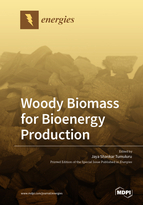Woody Biomass for Bioenergy Production
A special issue of Energies (ISSN 1996-1073). This special issue belongs to the section "A4: Bio-Energy".
Deadline for manuscript submissions: closed (29 February 2020) | Viewed by 48160
Special Issue Editor
Interests: biomass logistics; biomass preprocessing and pretreatment and size reduction and densification technologies; thermal pretreatment technologies; techno-economic analysis; data science; modeling and optimization of the processes; byproduct utilization; cotton ginning
Special Issues, Collections and Topics in MDPI journals
Special Issue Information
Dear Colleagues,
As an important renewable and sustainable energy resource, forest biomass is considered as the primary energy resource. Woody biomass can be converted to biofuels by different methods, such as thermal, chemical, and biochemical methods. Woody biomass, as an energy source, can either be used directly via combustion to produce heat, or indirectly after converting it to different biofuels. The focus of this Special Issue to classify woody biomass, harvesting technologies, supply chain logistics, physical and chemical properties, mechanical preprocessing (size reduction, and densification), and drying. In this Special Issue, emphasis will be on thermal pretreatments, such as torrefaction and hydrothermal carbonization, which makes woody biomass suitable for cofiring and thermochemical conversion to produce liquid fuels using technologies like pyrolysis and gasification. International trade of solid and liquid fuel products produced using woody biomass is also within the scope of the Special Issue.
Dr. Jaya Tumuluru
Guest Editor
Manuscript Submission Information
Manuscripts should be submitted online at www.mdpi.com by registering and logging in to this website. Once you are registered, click here to go to the submission form. Manuscripts can be submitted until the deadline. All submissions that pass pre-check are peer-reviewed. Accepted papers will be published continuously in the journal (as soon as accepted) and will be listed together on the special issue website. Research articles, review articles as well as short communications are invited. For planned papers, a title and short abstract (about 100 words) can be sent to the Editorial Office for announcement on this website.
Submitted manuscripts should not have been published previously, nor be under consideration for publication elsewhere (except conference proceedings papers). All manuscripts are thoroughly refereed through a single-blind peer-review process. A guide for authors and other relevant information for submission of manuscripts is available on the Instructions for Authors page. Energies is an international peer-reviewed open access semimonthly journal published by MDPI.
Please visit the Instructions for Authors page before submitting a manuscript. The Article Processing Charge (APC) for publication in this open access journal is 2600 CHF (Swiss Francs). Submitted papers should be well formatted and use good English. Authors may use MDPI's English editing service prior to publication or during author revisions.
Keywords
- woody biomass
- types and classification
- harvesting technologies
- storage methods and issues
- size reduction,
- drying
- densification
- torrefaction
- hydrothermal carbonization
- gasification
- pyrolysis
- transportation logistics
- international market






